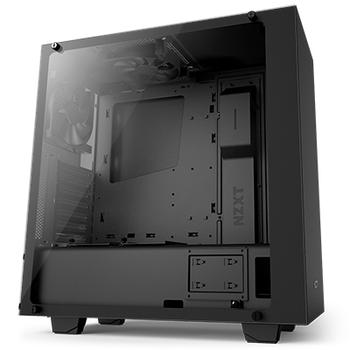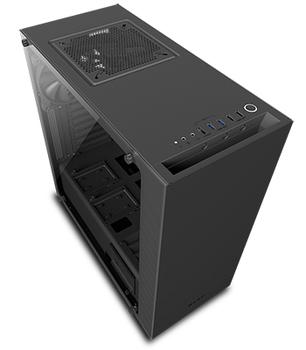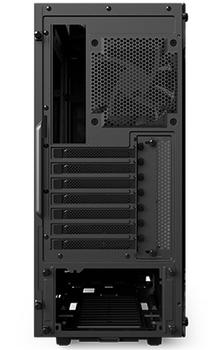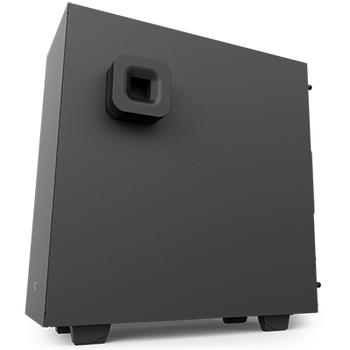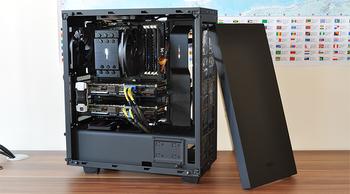Introduction
NZXT's Source 340 (S340) struck a lot of the right notes when it arrived on the scene back in 2014, and it's clear to see why. For less than £65 the chassis offers a lot of what's good about the pricier H440, making it a favoured choice for a low-cost yet powerful build.
Fast forward a few years and NZXT is hoping to build on the success of the original S340 with a refreshed sibling dubbed the S340 Elite. The new addition to the range is making its way onto retail shelves priced at £90, representing a near-40 per cent premium over the standard model.
Available in a choice of black, black/red and white colour schemes, the Elite has plenty in common with the standard S340 and shares identical dimensions of 203mm (W) x 474mm (H) x 432mm (D). A reasonably compact frame for a mid-tower solution, and NZXT's presentation and build quality are both of a high standard.
Our all-black review sample is well-knitted together, and of course it's the tempered glass side panel that immediately catches the eye. All the rage on modern enclosures, the glass window provides an extra sense of style and NZXT's implementation is solid. Four padded thumb screws hold the panel in place, and the glass is sufficiently thick with just the right amount of tint. It's a good-looking case whose matte paintwork serves as an elegant finish touch.
A large glass panel is a key contributor to the increased price, yet there are other tweaks throughout. The front I/O panel is now home to HDMI-out and a further two USB ports in a layout which NZXT reckons is well suited to a streamlined VR experience. The integrated HDMI cable is pre-routed through a small slot at the back of the chassis where it's easily connected to a compatible graphics card, and the VR-friendly additions don't stop there.
The strange-looking item attached to the side panel in the above picture is, in case you were wondering, a 'headset and VR cable management puck'. Magnetically secured to the case, it allows for headset cables to be wound around its centre and effectively serves as an elaborate mount on which to hang your VR head unit. Handy if virtual reality is your thing, however it's a shame NZXT hasn't addressed any other lingering I/O concerns - there's no reset button (as was the case with the original S340) and the Elite sadly doesn't introduce front-facing USB Type-C.
Not a great deal has changed on the inside, though that's by no means a criticism. In keeping with the 2014 model, the 2016 refresh supports a CPU cooler standing up to 161mm in height, while graphics cards can measure up to 364mm in length. Ample room to work with and either a Mini-ITX, Micro-ATX or ATX motherboard will slot in with ease. Drive support is slightly enhanced, with NZXT adding a third 2.5in SSD tray to the PSU shroud, and there are still two 3.5in hard-disk bays positioned at the end of the PSU compartment.
High-end hardware fits in neatly, as illustrated by our dual-GPU test platform, however the S340's budget-friendly intentions are still present on the pricier Elite. None of the drive trays are tool-free, the side panels are notched as opposed to hinged, and some of the advanced features available to NZXT's own H440 - sound-dampening materials, integrated lighting and a PWM fan hub - haven't made the cut.
Front and bottom dust filters offer easy cleaning, with the former accessed by pulling away the front panel and the latter sliding out from beneath the PSU. Cable management is undoubtedly a plus point, with the S340 Elite introducing four cable clamps - two large, two small - that enhance the already impressive cable-routing opportunities. Keeping things tidy is a cinch, and with a little care you shouldn't see any clutter through the front window.
How about cooling? Well, while the H440 ships with four fans as standard, the S340 Elite continues with just two - a 120mm in the rear and a 120mm up top. Both are configured as exhausts, and the three-pin headers are by default attached to a Molex Y-splitter for connecting directly to the PSU. Do note that the top fan can be swapped for a 140mm unit, and dual 120/140 mounts at the front of the case allow for optional intakes or a 240/280 radiator.



